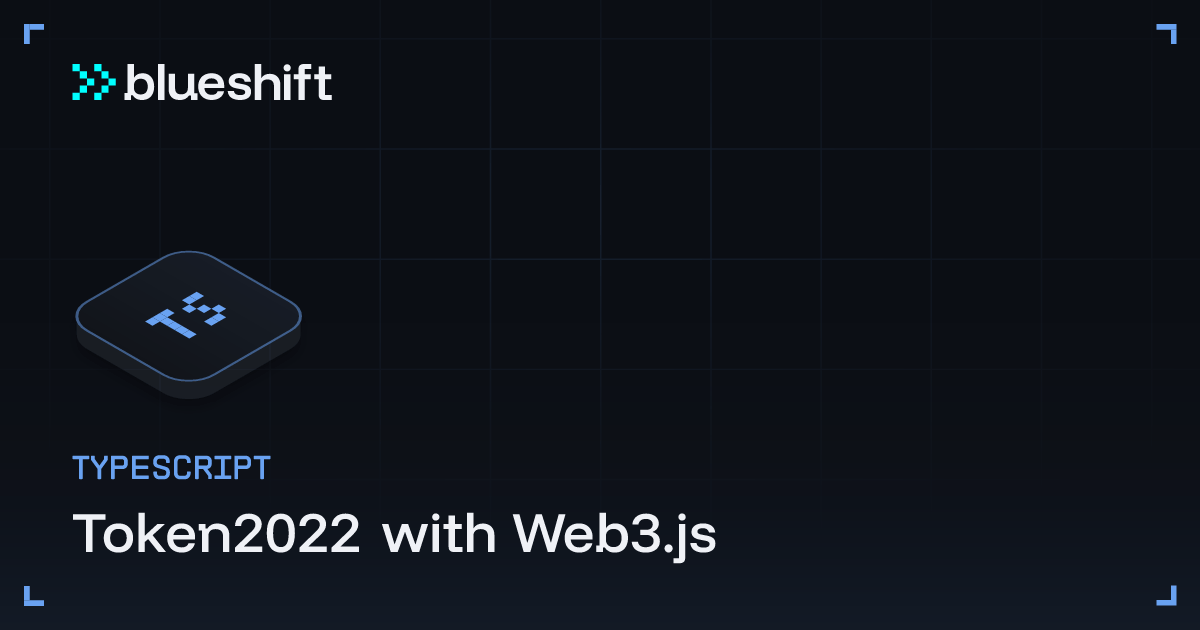The Token2022 Program

The Token2022 Program, also known as Token Extensions, is a superset of the functionality provided by the Token Program.
If you want to learn more about what additional functionalities are available and what are the differences with the Legacy token program, go follow this course
Let's start by installing the required package to work with the SPL Token program using Web3.js:
npm i @solana/spl-tokenMint and Token Accounts
If you're familiar with creating Mint accounts, Associated Token accounts, or Token accounts using TypeScript, you'll find that Token2022 follows a very similar pattern.
The main difference lies in account initialization, as extensions require additional space and must be configured before the mint is finalized.
Mint Account with Extensions
When adding extensions to a Mint, we need to:
Calculate the additional space required for extension data
Initialize each extension with its specific configuration
Ensure proper ordering of initialization instructions
Here's how to create a mint with the Transfer Fee extension:
import {
Keypair,
SystemProgram,
Transaction,
sendAndConfirmTransaction,
} from '@solana/web3.js';
import {
createInitializeMintInstruction,
createInitializeTransferFeeConfigInstruction,
getMintLen,
ExtensionType,
TOKEN_2022_PROGRAM_ID,
} from '@solana/spl-token';
const mint = Keypair.generate();
// Calculate the size needed for a Mint account with Transfer Fee extension
const mintLen = getMintLen([ExtensionType.TransferFeeConfig]);
// Calculate minimum lamports required for rent exemption
const lamports = await connection.getMinimumBalanceForRentExemption(mintLen);
// Create the account with the correct size and owner
const createAccountInstruction = SystemProgram.createAccount({
fromPubkey: keypair.publicKey,
newAccountPubkey: mint.publicKey,
space: mintLen,
lamports,
programId: TOKEN_2022_PROGRAM_ID,
});
// Initialize the Transfer Fee extension
const initializeTransferFeeConfig = createInitializeTransferFeeConfigInstruction(
mint.publicKey,
keypair.publicKey,
keypair.publicKey,
500,
BigInt(1e6),
TOKEN_2022_PROGRAM_ID,
);
// Initialize the mint itself
const initializeMintInstruction = createInitializeMintInstruction(
mint.publicKey,
6,
keypair.publicKey,
null,
TOKEN_2022_PROGRAM_ID,
);
// Combine all instructions in the correct order
const transaction = new Transaction().add(
createAccountInstruction,
initializeTransferFeeConfig, // Extension must be initialized before mint
initializeMintInstruction,
);
const signature = await sendAndConfirmTransaction(connection, transaction, [keypair, mint]);
console.log(`Mint created! Check out your TX here: https://explorer.solana.com/tx/${signature}?cluster=devnet`);As you can see, it's pretty straightforward:
Generate the
Mintkeypair using theKeypair.generate()function.Calculate the length of the
Mintaccount with specific extension using thegetMintLen()functionCalculate the minimum lamports needed using the
connection.getMinimumBalanceForRentExemption(mintLen)Create an account with the correct length, rent and owner
Initialize the extension you want on the
Mintaccount with the relative functionalitiesInitialize the
Mintaccount
Associated Token Account with Extensions
Associated Token accounts comes with the ImmutableOwner extension by default. So the only difference between the creation of a Legacy or Token2022 Token Account is just the owner program.
Here's how to create an Associated Token account:
const ata = await getAssociatedTokenAddress(
mint.publicKey,
keypair.publicKey,
false,
TOKEN_2022_PROGRAM_ID
);
// Create ATA creation instructions for all accounts
const createAtaInstructions = createAssociatedTokenAccountIdempotentInstruction(
keypair.publicKey, // payer
ata, // associated token account address
keypair.publicKey, // owner
mint.publicKey, // mint
TOKEN_2022_PROGRAM_ID
)Token Account with Extensions
The mechanism creating a Token account with extensions is similar to what we did with the Mint account:
Calculate the additional space required for extension data
Initialize each extension with its specific configuration
Ensure proper ordering of initialization instructions
Here's how to create a Token account with the CpiGuard extension:
const tokenAccount = Keypair.generate();
// Size of Token Account with extensions
const accountLen = getAccountLen([ExtensionType.CpiGuard]);
// Minimum lamports required for Token Account
const lamports = await connection.getMinimumBalanceForRentExemption(accountLen);
const createAccountInstruction = SystemProgram.createAccount({
fromPubkey: keypair.publicKey,
newAccountPubkey: tokenAccount.publicKey,
space: accountLen,
lamports,
programId: TOKEN_2022_PROGRAM_ID,
});
const enableCpiGuardInstruction = createEnableCpiGuardInstruction(
tokenAccount.publicKey,
keypair.publicKey,
undefined,
TOKEN_2022_PROGRAM_ID,
);
const initializeAccountInstruction = createInitializeAccountInstruction(
tokenAccount.publicKey,
mint.publicKey,
keypair.publicKey,
TOKEN_2022_PROGRAM_ID,
);
const transaction = new Transaction().add(
createAccountInstruction,
initializeAccountInstruction,
enableCpiGuardInstruction,
);
const signature = await sendAndConfirmTransaction(connection, transaction, [keypair, tokenAccount], {commitment: "finalized"});
console.log(`Token accounts created! Check out your TX here: https://explorer.solana.com/tx/${signature}?cluster=devnet`);